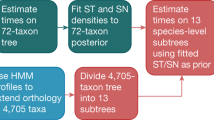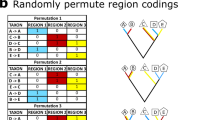Abstract
A timescale is necessary for estimating rates of molecular and morphological change in organisms and for interpreting patterns of macroevolution and biogeography1,2,3,4,5,6,7,8,9. Traditionally, these times have been obtained from the fossil record, where the earliest representatives of two lineages establish a minimum time of divergence of these lineages10. The clock-like accumulation of sequence differences in some genes provides an alternative method11 by which the mean divergence time can be estimated. Estimates from single genes may have large statistical errors, but multiple genes can be studied to obtain a more reliable estimate of divergence time1,12,13. However, until recently, the number of genes available for estimation of divergence time has been limited. Here we present divergence-time estimates for mammalian orders and major lineages of vertebrates, from an analysis of 658 nuclear genes. The molecular times agree with most early (Palaeozoic) and late (Cenozoic) fossil-based times, but indicate major gaps in the Mesozoic fossil record. At least five lineages of placental mammals arose more than 100 million years ago, and most of the modern orders seem to have diversified before the Cretaceous/Tertiary extinction of the dinosaurs.
This is a preview of subscription content, access via your institution
Access options
Subscribe to this journal
Receive 51 print issues and online access
$199.00 per year
only $3.90 per issue
Buy this article
- Purchase on Springer Link
- Instant access to full article PDF
Prices may be subject to local taxes which are calculated during checkout




Similar content being viewed by others
References
Wilson, A. C., Carlson, S. S. & White, T. J. Biochemical evolution. Annu. Rev. Biochem. 46, 573–639 (1977).
Nei, M. Molecular Evolutionary Genetics (Columbia Univ. Press, New York, 1987).
Novacek, M. J. Mammalian phylogeny: shaking the tree. Nature 356, 121–125 (1992).
Martin, R. D. Primate origins: plugging the gaps. Nature 363, 223–234 (1993).
Avise, J. C. Molecular Markers, Natural History and Evolution (Chapman & Hall, New York, 1994).
Hallam, A. An Outline of Phanerozoic Biogeography (Oxford Univ. Press, New York, 1994).
Easteal, S., Collet, C. & Betty, D. The Mammalian Molecular Clock (R. G. Landes, Austin, TX, 1995).
Gerhart, J. & Kirschner, M. Cells, Embryos, and Evolution (Blackwell Scientific, Malden, Massachusetts, 1997).
Gee, H. Before the Backbone (Chapman & Hall, New York, NY, 1996).
Benton, M. J. The Fossil Record 2 (Chapman & Hall, London, 1993).
Zuckerkandl, E. On the molecular evolutionary clock. J. Mol. Evol. 26, 34–46 (1987).
Hedges, S. B., Parker, P. H., Sibley, C. G. & Kumar, S. Continental breakup and the ordinal diversification of birds and mammals. Nature 381, 226–229 (1996).
Takezaki, N., Rzhetsky, A. & Nei, M. Phylogenetic test of the molecular clock and linearized tree. Mol. Biol. Evol. 12, 823–833 (1995).
Benton, M. J. Vertebrate Paleontology (Chapman & Hall, New York, 1997).
Archibald, J. D. Fossil evidence for a late Cretaceous origin of “hoofed” mammals. Science 272, 1150–1153 (1996).
Kielan-Jaworowska, Z. Interrelationships of Mesozoic mammals. Hist. Biol. 6, 185–202 (1992).
Cooper, A. & Penny, D. Mass survival of birds across the Cretaceous-Tertiary boundary: molecular evidence. Science 275, 1109–1113 (1997).
Kay, R. F., Ross, C. & Williams, B. A. Anthropoid origins. Science 275, 797–804 (1997).
Ward, S. in Function, Phylogeny, and Fossils (eds Begun, D. R., Ward, C. V. & Rose, M. D.) 269–290 (Plenum, New York, 1997).
Pilbeam, D. Genetic and morphological records of the Hominoidea and hominid origins: a synthesis. Mol. Phyl. Evol. 5, 155–168 (1996).
Benefit, B. R. & McCrossin, M. L. Earliest known Old World monkey skull. Nature 388, 368–371 (1997).
Jaeger, J.-J., Tong, H. & Denys, C. The age of the Mus-Rattus divergence: paleontological data compared with the molecular clock. C. R. Acad. Sci. Paris 302, 917–922 (1986).
Parker, P. H. An Improved Estimate of the Mouse-Rat Divergence Time and Rates of Amino Acid Substitution in Mammals and BirdsThesis, Pennsylvania State Univ.((1996).
Carroll, R. L. Vertebrate Paleontology and Evolution (W. H. Freeman and Co., New York, 1988).
Springer, M. S. et al. Endemic African mammals shake the phylogenetic tree. Nature 388, 61–63 (1997).
Duret, L., Mouchiroud, D. & Gouy, M. HOVERGEN: a database of homologous vertebrate genes. Nucleic Acids Res. 22, 2360–2365 (1994).
Tajima, F. Simple methods for testing the molecular evolutionary clock hypothesis. Genetics 135, 599–607 (1993).
Kumar, S., Tamura, K. & Nei, M. MEGA: Molecular Evolutionary Genetic Analysis (Pennsylvania State Univ., 1993).
Gheerbrant, E., Sudre, J. & Cappetta, H. APaleocene proboscidean from Morocco. Nature 383, 68–70 (1996).
Benton, M. J. Phylogeny of the major tetrapod groups: morphological data and divergence dates. J. Mol. Evol. 30, 409–424 (1990).
Acknowledgements
We thank L. Poling, A. Beausang, and R. Padmanabhan for assistance with sequence data retrieval; A. Beausang for artwork; A. G. Clark, C. A. Hass, I. Jakobsen, M. Nei, C. R. Rao, and A.Walker for comments and discussion; and L. Duret for instructions on use of the HOVERGEN database. This work was supported in part by grants to M. Nei (NIH and NSF) and S.B.H. (NSF).
Author information
Authors and Affiliations
Corresponding author
Supplementary Information
Rights and permissions
About this article
Cite this article
Kumar, S., Hedges, S. A molecular timescale for vertebrate evolution. Nature 392, 917–920 (1998). https://doi.org/10.1038/31927
Received:
Accepted:
Issue Date:
DOI: https://doi.org/10.1038/31927
This article is cited by
-
Integration-free induced pluripotent stem cells from three endangered Southeast Asian non-human primate species
Scientific Reports (2024)
-
An ancient polymorphic regulatory region within the BDNF gene associated with obesity modulates anxiety-like behaviour in mice and humans
Molecular Psychiatry (2024)
-
Olfactory-induced locomotion in lampreys
Cell and Tissue Research (2022)
-
Universal nomenclature for oxytocin–vasotocin ligand and receptor families
Nature (2021)
-
Major histocompatibility complex genes and locus organization in the Komodo dragon (Varanus komodoensis)
Immunogenetics (2021)
Comments
By submitting a comment you agree to abide by our Terms and Community Guidelines. If you find something abusive or that does not comply with our terms or guidelines please flag it as inappropriate.



